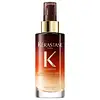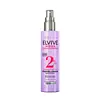Kérastase Nutritive 8H Magic Night Serum Hydrating Treatment Versus L'Oreal Elvive Hyaluron Plump Moisture Plump Serum
What's inside
What's inside
 Key Ingredients
Key Ingredients

 Benefits
Benefits

 Concerns
Concerns

 Ingredients Side-by-side
Ingredients Side-by-side

Water
Skin ConditioningDimethicone
EmollientC13-16 Isoalkane
SolventNiacinamide
SmoothingGlycerin
HumectantPolyacrylamide
Phenoxyethanol
PreservativeC13-14 Isoparaffin
EmollientLaureth-7
EmulsifyingPanthenol
Skin ConditioningAscorbyl Glucoside
AntioxidantButylene Glycol
HumectantLinalool
PerfumingHydroxycitronellal
PerfumingBenzyl Salicylate
PerfumingBenzyl Alcohol
PerfumingHexyl Cinnamal
PerfumingCitronellol
PerfumingHydrolyzed Wheat Protein
Skin ConditioningAlpha-Isomethyl Ionone
PerfumingCoumarin
PerfumingHydrolyzed Corn Protein
Skin ConditioningHydrolyzed Soy Protein
HumectantLimonene
PerfumingIris Florentina Root Extract
MaskingCitric Acid
BufferingCI 19140
Cosmetic ColorantCI 14700
Cosmetic ColorantParfum
MaskingWater, Dimethicone, C13-16 Isoalkane, Niacinamide, Glycerin, Polyacrylamide, Phenoxyethanol, C13-14 Isoparaffin, Laureth-7, Panthenol, Ascorbyl Glucoside, Butylene Glycol, Linalool, Hydroxycitronellal, Benzyl Salicylate, Benzyl Alcohol, Hexyl Cinnamal, Citronellol, Hydrolyzed Wheat Protein, Alpha-Isomethyl Ionone, Coumarin, Hydrolyzed Corn Protein, Hydrolyzed Soy Protein, Limonene, Iris Florentina Root Extract, Citric Acid, CI 19140, CI 14700, Parfum
Water
Skin ConditioningPolyquaternium-37
Parfum
MaskingPropylene Glycol Dicaprylate/Dicaprate
EmollientPolysorbate 20
EmulsifyingQuaternium-87
CleansingStearyl Alcohol
EmollientGlycine Soja Oil
EmollientSodium Benzoate
MaskingCaprylyl Glycol
EmollientBehentrimonium Chloride
PreservativePPG-1 Trideceth-6
Skin ConditioningCocos Nucifera Oil
MaskingCandelilla Cera
EmollientPropylene Glycol
HumectantCitric Acid
BufferingIsopropyl Alcohol
SolventSorbitan Oleate
EmulsifyingPentaerythrityl Tetra-Di-T-Butyl Hydroxyhydrocinnamate
AntioxidantPolyquaternium-11
Sodium Hyaluronate
HumectantLimonene
PerfumingCoumarin
PerfumingWater, Polyquaternium-37, Parfum, Propylene Glycol Dicaprylate/Dicaprate, Polysorbate 20, Quaternium-87, Stearyl Alcohol, Glycine Soja Oil, Sodium Benzoate, Caprylyl Glycol, Behentrimonium Chloride, PPG-1 Trideceth-6, Cocos Nucifera Oil, Candelilla Cera, Propylene Glycol, Citric Acid, Isopropyl Alcohol, Sorbitan Oleate, Pentaerythrityl Tetra-Di-T-Butyl Hydroxyhydrocinnamate, Polyquaternium-11, Sodium Hyaluronate, Limonene, Coumarin
 Reviews
Reviews

Ingredients Explained
These ingredients are found in both products.
Ingredients higher up in an ingredient list are typically present in a larger amount.
Citric Acid is an alpha hydroxy acid (AHA) naturally found in citrus fruits like oranges, lemons, and limes.
Like other AHAs, citric acid can exfoliate skin by breaking down the bonds that hold dead skin cells together. This helps reveal smoother and brighter skin underneath.
However, this exfoliating effect only happens at high concentrations (20%) which can be hard to find in cosmetic products.
Due to this, citric acid is usually included in small amounts as a pH adjuster. This helps keep products slightly more acidic and compatible with skin's natural pH.
In skincare formulas, citric acid can:
While it can provide some skin benefits, research shows lactic acid and glycolic acid are generally more effective and less irritating exfoliants.
Most citric acid used in skincare today is made by fermenting sugars (usually from molasses). This synthetic version is identical to the natural citrus form but easier to stabilize and use in formulations.
Read more about some other popular AHA's here:
Learn more about Citric AcidCoumarins are a group of substances found naturally in plants. There are over 1300 types of coumarins identified. It has a natural vanilla scent.
Coumarin is an identified EU known allergy, meaning it may cause an allergic reaction when applied to the skin.
In many countries, coumarin is banned as a food additive. However, it can be found in soaps, tobacco products, and some alcohol drinks.
Plants use coumarins as a chemical defense. Some plants that have coumarins include lavender, tonka beans, and yellow clovers.
Learn more about CoumarinLimonene is a fragrance that adds scent and taste to a formulation.
It's found in the peel oil of citrus fruits and other plants such as lavender and eucalyptus. The scent of limonene is generally described as "sweet citrus".
Limonene acts as an antioxidant, meaning it helps neutralize free radicals.
When exposed to air, oxidized limonene may sensitize the skin. Because of this, limonene is often avoided by people with sensitive skin.
The term 'fragrance' is not regulated in many countries. In many cases, it is up to the brand to define this term. For instance, many brands choose to label themselves as "fragrance-free" because they are not using synthetic fragrances. However, their products may still contain ingredients such as essential oils that are considered a fragrance.
Learn more about LimoneneParfum is a catch-all term for an ingredient or more that is used to give a scent to products.
Also called "fragrance", this ingredient can be a blend of hundreds of chemicals or plant oils. This means every product with "fragrance" or "parfum" in the ingredients list is a different mixture.
For instance, Habanolide is a proprietary trade name for a specific aroma chemical. When used as a fragrance ingredient in cosmetics, most aroma chemicals fall under the broad labeling category of “FRAGRANCE” or “PARFUM” according to EU and US regulations.
The term 'parfum' or 'fragrance' is not regulated in many countries. In many cases, it is up to the brand to define this term.
For instance, many brands choose to label themselves as "fragrance-free" because they are not using synthetic fragrances. However, their products may still contain ingredients such as essential oils that are considered a fragrance by INCI standards.
One example is Calendula flower extract. Calendula is an essential oil that still imparts a scent or 'fragrance'.
Depending on the blend, the ingredients in the mixture can cause allergies and sensitivities on the skin. Some ingredients that are known EU allergens include linalool and citronellol.
Parfum can also be used to mask or cover an unpleasant scent.
The bottom line is: not all fragrances/parfum/ingredients are created equally. If you are worried about fragrances, we recommend taking a closer look at an ingredient. And of course, we always recommend speaking with a professional.
Learn more about ParfumWater. It's the most common cosmetic ingredient of all. You'll usually see it at the top of ingredient lists, meaning that it makes up the largest part of the product.
So why is it so popular? Water most often acts as a solvent - this means that it helps dissolve other ingredients into the formulation.
You'll also recognize water as that liquid we all need to stay alive. If you see this, drink a glass of water. Stay hydrated!
Learn more about Water